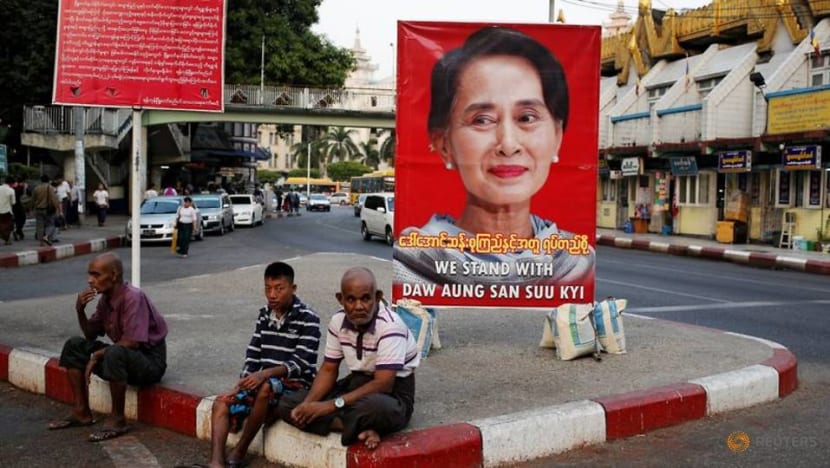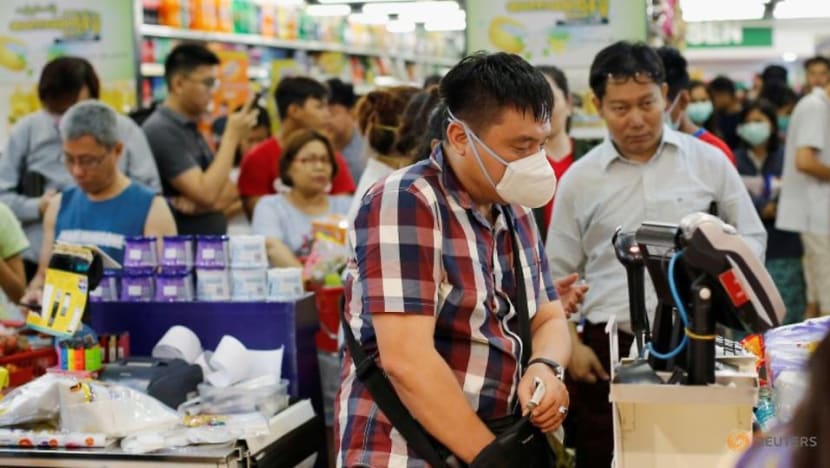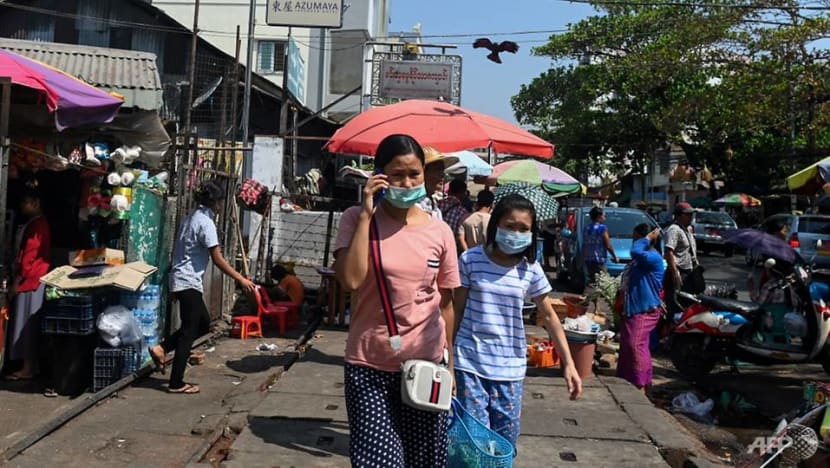commentary Commentary
Commentary: Has Myanmar been in denial over COVID-19 outbreak all this while?
Myanmar’s poor healthcare infrastructure will make it very challenging for the country to deal decisively with the outbreak, says Dr Nehginpao Kipgen.

A poster supporting Aung San Suu Kyi on a road in Yangon, Myanmar, Dec 12, 2019. (File photo: Reuters/Ann Wang)
NEW DELHI: Myanmar confirmed its first two cases of coronavirus late on Monday (Mar 23) after weeks of maintaining the claim the country was free from the virus.
The news sparked panic buying in the commercial capital of Yangon with shoppers packing major supermarkets.
While it may have come as a shock to many Myanmar residents, it was not a surprise to many observers. In fact, most global health experts have found Myanmar’s lack of infections extraordinary and pointed to the low numbers of testing – of about 300 as of Monday evening in a 51 million population.
Given limited supplies, helped but not resolved by assistance of more test kits from China and Singapore, each test until recently had to be approved by a central committee based in the country’s capital, Naypyidaw.
READ: Commentary: Developing affordable, accurate test kits for COVID-19 one of the biggest challenge this outbreak
READ: Commentary: Japan really needs to get cracking on coronavirus testing
DENIAL DESPITE VULNERABILITY
Myanmar must expect more infections, even deaths, in the coming days, given its vulnerability to the importation of cases and the appalling lack of healthcare capacity to deal with an outbreak.
Denial underpinning a reluctance to carry out aggressive measures to stem an outbreak may be Myanmar’s ultimate undoing.
Chief spokesman for the Myanmar government U Zaw Htay said just last week that the absence of positive tests was proof that the virus has not reached Myanmar because of “the lifestyle and diet of Myanmar citizens”.
And just days before the World Health Organization (WHO) declared COVID-19 a pandemic, State Counsellor Aung San Suu Kyi had been hosting large crowds of supporters and visiting states across the country, with an eye on the November election.

Myanmar has held the line that it had no cases of the virus, despite sharing over 2,200km-long porous border with China, where the virus had originated, a 2,100km-long border with Thailand, an early hotbed for the outbreak.
People flows between these countries have been on the uptick in recent years. Chinese tourists to Myanmar increased significantly last year compared to the previous year.
Myanmar welcomed a total of almost 750,000 Chinese visitors, the largest source country of tourism, in 2019, which was a 152 per cent increase from 2018, according to Myanmar’s Ministry of Labour, Immigration and Population.
The easing of visa restrictions has also considerably prompted the increase of visitor arrivals last year to 4.37 million, up over 800,000 compared to the previous year. Arrival of visitors from Japan and South Korea rose by 50 per cent in 2019.
READ: Commentary: South Korea succeeded in controlling COVID-19 panic buying, thanks to tracking and surveillance
READ: Commentary: South Korea has been exemplary. Even then, it hasn’t slayed COVID-19
Myanmar also has about 27 land checkpoints between Bangladesh, India, China, Laos and Thailand although not all are open to foreign visitors. But approximately 200,000 foreign visitors used Myanmar’s land borders each month last year.
TRAVEL RESTRICTIONS MAY BE TOO LITTLE TOO LATE
Myanmar took very few early steps to stem the entry of visitors from infected regions.
Only days after the WHO declared the coronavirus a pandemic, did the Myanmar government take concrete measures to isolate foreign travellers.
On Mar 15, the Myanmar government ordered a mandatory 14 days of quarantine and surveillance for arrivals from some infected countries, including China, Korea, Italy, Iran and France.

It was also only on Mar 24 when the Myanmar government moved to mandate all Myanmar nationals entering the country to be quarantined for 14 days in a state facility, with foreigners required to show a clean bill of health from a registered clinic before boarding their flight to Myanmar.
These steps are important and necessary, but may be too late to prevent the spread of virus in the country, bearing in mind also that infected cases may not show symptoms in their initial days.
Moreover, thousands of migrant workers have returned to villages across the country from Thailand over this week.
POOR HEALTHCARE FACILITIES
Myanmar’s poor healthcare infrastructure will make it very challenging for the country to deal decisively with the outbreak.
The country’s healthcare system has been consistently ranked by the WHO as among the world’s worst after decades of neglect under military rule.
LISTEN: What's behind the different approaches countries are taking towards COVID-19?
READ: Commentary: Facing a two-front COVID-19 assault, Saudi Arabia pulls out the sledgehammer
While a few metropolitan cities such as Yangon, Naypyidaw and Mandalay have better hospitals and primary care structures, the vast majority of the country does not have access to even basic healthcare.
For a country that spends 2 per cent of GDP on healthcare and has struggled with managing basic problems related to communicable diseases like tuberculosis, many healthcare services are run by volunteers and aid groups.
Health service coverage has been poor, with 13 out of 15 territories having less than the WHO recommended minimum of one doctor for every 1,000 residents.

There are few signs Myanmar has the capacity to scale up testing, where samples of suspected patients had to be sent to Thailand for analysis at the start of the outbreak.
If the virus spreads more widely and quickly, Myanmar’s healthcare system will be hard pressed to cope up with the intensity, especially in further flung rural areas.
BRAVING THE STORM
The truth is that in a globalised world, with more people, goods and services crossing national borders, Myanmar, like any other country around the world, is susceptible to the COVID-19.
READ: Commentary: Are people with blood group A at higher risk of catching COVID-19?
READ: Commentary: The world’s airlines are headed for a crash landing. Government parachutes need to be activated now
It realises this and is doing a huge about-turn. The shutting down of schools, cinemas, karaoke bars, massage parlours, and the cancellation of the popular new year water festival by the authorities in recent days has been a commendable effort to jolt the public while it attempts to educate citizens of the need for social distancing.
Instead of downplaying the situation, the authorities should encourage people to come forward for testing if they show symptoms. Testing facilities and quarantine centres should also be made accessible across the country.
Despite the differences and disagreements along lines of party, ethnicity and religion, Myanmar must come together to fight the deadly disease.
Myanmar’s first cases may be the tip of the iceberg for a country that has claimed to be coronavirus free for weeks. It is time for the NLD government to demonstrate leadership and protect its people.
BOOKMARK THIS: Our comprehensive coverage of the novel coronavirus and its developments
Download our app or subscribe to our Telegram channel for the latest updates on the coronavirus outbreak: https://cna.asia/telegram
Dr Nehginpao Kipgen is a Political Scientist, Associate Professor, Assistant Dean and Executive Director at the Center for Southeast Asian Studies, Jindal School of International Affairs, O.P. Jindal Global University. He is the author of three books on Myanmar, including ‘Democratization of Myanmar’.














